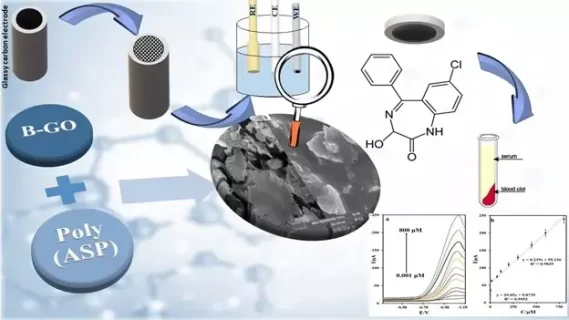A glassy carbon electrode modified with boron-doped graphene oxide/ polyaspartic acid for electrochemical determination of oxazepam
Authors
Abstract
In this study, the electrochemical determination of oxazepam in plasma samples was studied. The composite of graphene oxide/boron (B-RGO) was synthesized via the hydrothermal method and it was cast on the glassy carbon electrode (GCE). The polyaspartic acid (poly(ASP)) was deposited on the B-RGO by electropolymerization to prepare the modified electrode named B-RGO/ poly(ASP)|GCE. The B-RGO and B-RGO/poly ASP were characterized using scanning electron microscopy (SEM) and Fourier transform infrared spectroscopy (FTIR). Electrochemical studies were performed by cyclic voltammetry (CV), linear sweep voltammetry (LSV) and differential pulse voltammetry (DPV) methods. The experimental parameters affecting the reduction of oxazepam such as pH, preconcentration time, scan rate and other analysis conditions, and instrumental parameters were optimized. Under the optimal conditions, the linear range was obtained from 0.001 to 800 μM with a correlation coefficient of 0.998. The repeatability of the method for the electrode to electrode and one electrode were 4.3% and 4.9%, respectively. The limit of detection (LOD) of 0.3 nM and the limit of quantitation (LOQ) of 1 nM were obtained. The high efficiency of the developed electrode in the determination of oxazepam in the plasma sample was proved by using acceptable results and satisfactory relative recovery percentage (>90%). Based on our calculation, the heterogeneous electron transfer rate constant (ks) was 1.92 s-1. The interaction between oxazepam and modifier was single-layer and multi-layer adsorption, respectively in low and high concentrations.
Highlights
- The electrochemical determination of oxazepam in plasma samples was studied.
- The method is featured with low cost, high extraction recovery and rapid operation and trace analysis.
- The composite of graphene oxide/born/polyaspartic acid was used for modification of glassy carbon electrode as a working electrode.
- DPV has been used as quantitation method due to its fast analysis time and more sensitivity than CV.




